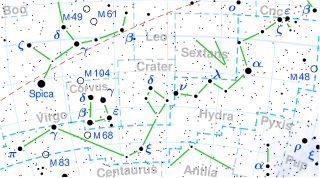제타 하이드레이
Zeta Hydrae| 관측 데이터 신기루J2000.0이쿼녹스J2000.0 | |
|---|---|
| 별자리 | 히드라 |
| 우측 상승 | 08h 55m 23.62614s[1] |
| 탈위임 | +05° 56′ 44.0354″[1] |
| 겉보기 크기(V) | 3.10[2] |
| 특성. | |
| 스펙트럼형 | G9 II-III[3] |
| U-B색지수 | +0.82[2] |
| B-V색지수 | +1.00[2] |
| 아스트로메트리 | |
| 방사 속도(Rv) | +22.8km[4]/s |
| 적정운동(μ) | RA: –100.06[1]mas/yr Dec.: +15.46[1]mas/yr |
| 시차(시차) | 19.51 ± 0.18 mas[1] |
| 거리 | 167 ± 2 리 (51.3 ± 0.5 pc) |
| 절대치수(MV) | –0.24[5] |
| 세부 사항 | |
| 미사 | 4.2[6] M☉ |
| 반지름 | 17.9[7] R☉ |
| 루미도 | 132[7] L☉ |
| 표면 중력(log g) | 2.48[7] cgs |
| 온도 | 4925K[6] |
| 금속성 [Fe/H] | –0.21[8] 덱스 |
| 회전 속도(v sin i) | 2.5km[8]/s |
| 나이 | 400Merr[5] |
| 기타 지정 | |
| 데이터베이스 참조 | |
| 심바드 | 자료 |
제타 하이드레이(Zeta Hidrae, ζ Hydrae)는 히드라의 적도 별자리에 있는 외딴 별이다.이것은 일반적으로 희미한 별자리여서, 눈에 보이는 크기 +3.10에서는 알파드, 감마 하이드레이 다음으로 세 번째로 밝은 부재다.[2]
거리
이 별까지의 거리는 시차 기법을 사용하여 측정되었으며, 대략 167광년(51파섹)의 값을 산출한다.[1]이 거리에서는 가스와 먼지로 인한 소멸로 인해 별의 시각적 크기가 0.03만큼 감소한다.[5]델타 하이드레이는 제타 하이드레이에서 약 12.9광년(4.0파섹) 떨어져 있으며 주로 공동 움직이는 물체일 수 있다.[10]이 별은 20.7182 ± 0.3925 mas의 시차 및 정확하다면 157 ± 3 광년의 거리를 계산하는 가이아 우주선 중 낮은 오차의 여백 판독치 중 하나를 가지고 있다.[11]
특성.
G9 II-III의 별난 분류로,[3] 이것은 4,925K의 유효 온도에서 외부 외피로부터 태양의 132배[7] 광도를 방사하는 진화된 거대한 별이다.[6]이 더위에 별은 G형 별의 노란 빛깔로 빛난다.[12]이 별의 반지름은 간섭계로 측정했을 때 태양 반지름의 약 18배이다.[7]태양[6] 질량의 4.2배로 추정되며 약 4억년 전이다.[5]
이름과 어원
이 별은 Δ Hya(리산 알 수자), ε Hya, η Hya, ρ Hya, σ Hya(민치르)와 함께 울룩베크의 민알 아자알, "무인도적 지점으로 벨링"이었다.[13]According to the catalogue of stars in the Technical Memorandum 33-507 - A Reduced Star Catalog Containing 537 Named Stars, Min al Azʽal or Minazal were the title for five stars:δ Hya as Minazal I, η Hya as Minazal II, ε Hya as Minazal III, ρ Hya as Minazal IV and ζ Hya as Minazal V (exclude σ Hya).[14]
In Chinese, 柳宿 (Liǔ Sù), meaning Willow, refers to an asterism consisting of ζ Hydrae, δ Hydra, σ Hydrae, η Hydrae, ρ Hydrae, ε Hydrae, ω Hydrae and θ Hydrae[15] Consequently, ζ Hydrae itself is known as 柳宿六 (Liǔ Sù liù, English: the Sixth Star of Willow).[16]
그로테 아이랜드 사람들은 이 별인 Δ Hya(리산 알 수자), ), Hya, η Hya, and Hya, and Hya, σ Hya, min Hya(민치르)를 포함한 별 성단을 위해 언발라를 '게'[17]라고 불렀다.
참조
- ^ a b c d e f van Leeuwen, F. (November 2007), "Validation of the new Hipparcos reduction", Astronomy and Astrophysics, 474 (2): 653–664, arXiv:0708.1752, Bibcode:2007A&A...474..653V, doi:10.1051/0004-6361:20078357, S2CID 18759600
- ^ a b c d Jennens, P. A.; Helfer, H. L. (September 1975), "A new photometric metal abundance and luminosity calibration for field G and K giants.", Monthly Notices of the Royal Astronomical Society, 172 (3): 667–679, Bibcode:1975MNRAS.172..667J, doi:10.1093/mnras/172.3.667
- ^ a b Morgan, W. W.; Keenan, P. C. (1973), "Spectral Classification", Annual Review of Astronomy and Astrophysics, 11 (1): 29–50, Bibcode:1973ARA&A..11...29M, doi:10.1146/annurev.aa.11.090173.000333
- ^ Wielen, R.; et al. (1999), "Sixth Catalogue of Fundamental Stars (FK6). Part I. Basic fundamental stars with direct solutions", Veroeffentlichungen des Astronomischen Rechen-Instituts Heidelberg, Astronomisches Rechen-Institut Heidelberg, 35 (35): 1, Bibcode:1999VeARI..35....1W
- ^ a b c d Takeda, Yoichi; Sato, Bun'ei; Murata, Daisuke (August 2008), "Stellar parameters and elemental abundances of late-G giants", Publications of the Astronomical Society of Japan, 60 (4): 781–802, arXiv:0805.2434, Bibcode:2008PASJ...60..781T, doi:10.1093/pasj/60.4.781, S2CID 16258166
- ^ a b c d Ando, Hiroyasu; et al. (April 2008), "Detection of Small-Amplitude Oscillations in the G-Giant HD76294 (ξ Hydrae)", Publications of the Astronomical Society of Japan, 60 (2): 219–222, Bibcode:2008PASJ...60..219A, doi:10.1093/pasj/60.2.219
- ^ a b c d e Ando, Hiroyasu; Tsuboi, Yusuke; Kambe, Eiji; Sato, Bun'ei (August 2010), "Oscillations in G-Type Giants", Publications of the Astronomical Society of Japan, 62 (4): 1117–1126, arXiv:1007.1286, Bibcode:2010PASJ...62.1117A, doi:10.1093/pasj/62.4.1117, S2CID 118677219
- ^ a b Massarotti, Alessandro; et al. (January 2008), "Rotational and Radial Velocities for a Sample of 761 HIPPARCOS Giants and the Role of Binarity", The Astronomical Journal, 135 (1): 209–231, Bibcode:2008AJ....135..209M, doi:10.1088/0004-6256/135/1/209
- ^ "zet Hya". SIMBAD. Centre de données astronomiques de Strasbourg. Retrieved 2006-11-05.
- ^ Shaya, Ed J.; Olling, Rob P. (January 2011), "Very Wide Binaries and Other Comoving Stellar Companions: A Bayesian Analysis of the Hipparcos Catalogue", The Astrophysical Journal Supplement, 192 (1): 2, arXiv:1007.0425, Bibcode:2011ApJS..192....2S, doi:10.1088/0067-0049/192/1/2, S2CID 119226823
- ^ Brown, A. G. A.; et al. (Gaia collaboration) (August 2018). "Gaia Data Release 2: Summary of the contents and survey properties". Astronomy & Astrophysics. 616. A1. arXiv:1804.09365. Bibcode:2018A&A...616A...1G. doi:10.1051/0004-6361/201833051. 이 소스에 대한 가이아 DR2 기록 VizieR.
- ^ "The Colour of Stars", Australia Telescope, Outreach and Education, Commonwealth Scientific and Industrial Research Organisation, December 21, 2004, retrieved 2012-01-16
- ^ Allen, R. H. (1963), Star Names: Their Lore and Meaning (Reprint ed.), New York, NY: Dover Publications Inc, p. 249, ISBN 0-486-21079-0, retrieved 2010-12-12
- ^ Rhoads, Jack W. (November 15, 1971), Technical Memorandum 33-507-A Reduced Star Catalog Containing 537 Named Stars (PDF), Jet Propulsion Laboratory, California Institute of Technology
- ^ (in Chinese) 中國星座神話, written by 陳久金.Published by 台灣書房出版有限公司, 2005, ISBN 978-986-7332-25-7.
- ^ (중국어로) AEEA(천문학의 전시 및 교육의 활동) 天文教資 2006 2006 2006 2006 年 5 月 28 日
- ^ Selin, Helaine, ed. (1997), Encyclopaedia of the history of science, technology, and medicine in non-western cultures, Dordrecht: Kluwer Academic Publishers, p. 105, ISBN 9780792340669



